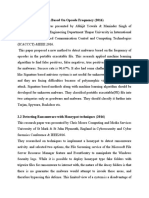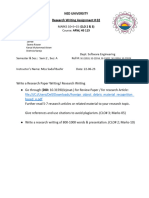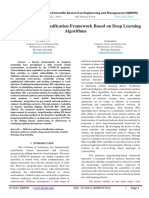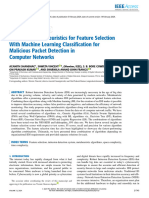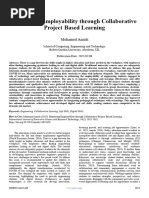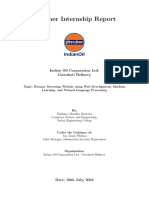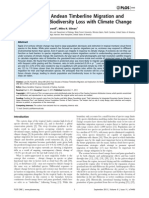Malware Detection Using Machine Learning
Malware Detection Using Machine Learning
Copyright:
Available Formats
Malware Detection Using Machine Learning
Malware Detection Using Machine Learning
Original Title
Copyright
Available Formats
Share this document
Did you find this document useful?
Is this content inappropriate?
Copyright:
Available Formats
Malware Detection Using Machine Learning
Malware Detection Using Machine Learning
Copyright:
Available Formats
Volume 9, Issue 4, April – 2024 International Journal of Innovative Science and Research Technology
ISSN No:-2456-2165 https://doi.org/10.38124/ijisrt/IJISRT24APR1102
Malware Detection using Machine Learning
Dilip Dalgade1 (Professor) Srushti Patyane2
Department of Computer Engineering Department of Computer Engineering
Rajiv Gandhi Institute of Technology, Rajiv Gandhi Institute of Technology,
Mumbai, India Mumbai, India
Anushka Matey3 Saloni Singh4
Department of Computer Engineering Department of Computer Engineering
Rajiv Gandhi Institute of Technology, Rajiv Gandhi Institute of Technology,
Mumbai, India Mumbai, India
Amey Godbole5
Department of Computer Engineering
Rajiv Gandhi Institute of Technology,
Mumbai, India
Abstract:- As the level of malware and viruses is on the instrumental and enables effective development of
rise, the prominence of effective detection systems is preventive defense mechanisms able to spot and kill all the
crucial. Malwares are the modern-day threats that have malware variants in real time. In this research, the paper
troubled major companies worldwide. This article allows to make a comparison between two machine learning
explores in depth two powerful machine learning tools, algorithms that are known to be the best at malware
Random Forest, Support Vector Machines in particular, detection, namely Random Forest and Support Vector
for the detection of malware. Our study revealed the Machines (SVM). The Random Forest approach is an
Random Forest's capacity to reach the upper detection advanced ensemble method that involves creation of many
accuracy limit of 98% by applying an analysis of a dataset decision trees in an attempt to boost precision of the
of various malware samples. The feature selection process classifier. One the other hand, SVM is efficient supervised
as well as the model improvement that we've adopted learning method which specializes in recognizing patterns
have substantially improved use of our approach for in complex datasets. This purpose will be achieved through
malware detection, and this is thereby highly crucial for the implementation of a dataset with a structured collection
organizations to fight against evolving cyber threats. The containing samples of malware.
results of the present research support the ongoing
actionsof strengthening cybersecurity security, therefore, Furthermore, the study delves into how the crucial
providing invaluable information for proactive defense factors like the feature selection and tuning of the models
approach mechanisms against malicious software and algorithms affect their performance. Through achieving
attacks. those targets, the research project at hand makes a valuable
support to the efforts in intensifying cybersecurity
Keywords:- Malware, Machine Learning, Random Forest, safeguards and minimizing the risks that come with
Support Vector Machines (SVM), Detection Accuracy, evolving cyber threats. The results of the investigation
Cybersecurity, Feature Selection, Model Optimization. which are of a practical nature are of a great help to
cybersecurity specialists toward the creation of strong
I. INTRODUCTION detection frameworks and network securing against malware
attacks.
In recent years, malware attacks have become a major
pain in the neck that have slowed down cybersecurity efforts II. LITERATURE SURVEY
and even disrupted the operations of organizations. The
crimeware species always remain in the mode of evolving The work of Tamás Csongor et al. [1] concentrated on
with sophistication of technologies and therefore the utilization of malwares hashes for effect detection. They
conventional signature-based detection methods are of little relied on both behavioral analysis and pattern recognition as
use against this. Therefore, novel techniques are the foundations of their technology generating automatic
increasingly being recognized as the most outstanding alerts in a manner that would allow for preventive threat
methodology that effectively recognized these threats and mitigation. While the results demonstrated their approach’s
quench them. Machine learning algorithms which have effectiveness, the research study was faced with challenges
proved to be greatly potential recently as a weapon fight pertaining to the integration of false positives/negatives
against malware. Through the use of computation that could potentially affect the accuracy of the detection
algorithms and big data analysis, the machine learning is outcome. Though their system was highly accurate,
IJISRT24APR1102 www.ijisrt.com 1949
Volume 9, Issue 4, April – 2024 International Journal of Innovative Science and Research Technology
ISSN No:-2456-2165 https://doi.org/10.38124/ijisrt/IJISRT24APR1102
SIMBIoTA had a true positive detection rate of 97-98% and In contrast, P Priyadarshan et al. [6] adopted a hybrid
many other capabilities, also the results proved its approach combining dynamic and static analysis techniques,
competence in discriminating malevolent software threats. utilizing k-NN, Logistic Regression, and Random Forest
algorithms for malware detection. Despite the absence of
To the work of S. Agarkar et al. [2], they showed that feature selection and reduction techniques, their approach
by the means of a combination of machine learning methods showcased a high accuracy rate of 99.1% with Random
namely Light GBM, Decision Tree, and Random Forest, the Forest, highlighting the synergistic benefits of combining
results were more robust and efficient. With a special different analysis methods in enhancing detection
emphasis on how to reduce false negatives and that of the capabilities.
security achievement better, their methodology was set. The
researchers also started experimenting with using larger Furthermore, M. Masum et al. [7] conducted a
datasets and adding more features to help improve the comprehensive assessment of machine learning classifiers,
discriminability of their classifiers afterward. To note, including Decision Tree, Random Forest, Bayesian, Logistic
however, the accurate rates they got were impressive, with Regression, and Neural Network, to identify the most
Tree Decision yielding 99.14%, Random Forest giving effective malware identifier. Their findings underscored the
99.47%, and Light GBM, with an impressive 99.50%, superiority of the Random Forest algorithm, which achieved
reasserting that their strategy worked perfectly in helping a classification rate of 99%, highlighting the efficacy of
the system recognize rogue software file types while ensemble learning techniques in improving detection
attaining high accuracy. efficiency.
The research led by S. A. Roseline [3] for assembly of Moreover, SH Kok et al. [8] conducted a comparative
hybrid multi-layered ransomware and the procedure of analysis of various ransomware detection techniques,
application of a random forest ensembling algorithm was encompassing state-of-the-art methods such as Bayesian
developed for the detection of malware. This involved Decision Tree, Dimension Reduction, Instance- Based,
their approach in finding a trade- off between computation Clustering, Deep Learning, Ensemble, Neural Network, and
and accuracy, highlighting efficiency as the basis of the Regression. While their study outlined the breadth of
whole process and at the same time, achieving a good techniques available for ransomware detection, detailed
detection performance. Yet, the limitation of the study on information regarding their hybrid algorithm configuration
using the testing set that was sized, might impact my was lacking. Nevertheless, their research contributed to
ability to generalize the result. Regardless of that is, their advancing the field of ransomware detection, paving the
proposed art technique has reached impressive success by way for more comprehensive and informative detection
bringing the accuracy rate of 98.91% while using up only a strategies.
few resources of thecomputation as they have demonstrated.
Lastly, Ham, Hyo-Sik et al. [9] focused on Android
The team of K. Sethi et al [4] applied a set of classical malware detection using a Linear Support Vector Machine
machine learning techniques including k-NN, SVM and (SVM) classifier, aiming to ensure reliable Internet of
Random Forest for the constituent family's malware class Things (IoT) services. Despite potential biases in the dataset,
distribution. They classified the malware being researched their findings demonstrated the superior performance of the
by determine their characteristics, functions, and exploits. Linear SVM classifier in accurately identifying malicious
On the other hand, one of therestrictions of their research software instances, highlighting its effectiveness in
was that they used their own hand-created data source, with enhancing malware detection efficiency, particularly in the
it being challenging to achieve real diversity and context of IoT security.
representativeness of modern malware samples like this.
The fact that there is a drawback to this finding makes it III. PROPOSED SYSTEM
more impressive that the Decision Tree algorithm, which is
able to be used, performed very well maintaining a precision In order to accomplish the task of discovering and
rate of 99.11%. This point shows the strength of their preventing malware, our structure combines different
solution which helps in precise classification of malware features selection methods and a number of various machine
family except constraints of dataset associated with it. learning methods, for example, Random Forest (RF),
Support Vector Machine (SVM), and cross validation.
Similarly, N.A Anuar et al. [5] explored the These techniques are used to pick up attribute set of
capabilities of machine learning classifiers, including Naïve population that is chosen by us intelligently. Lowered
Bayes, Support Vector Machine, Random Forest, and data quality and high correlation data features are detected
Decision Tree, in identifying malware threats. While their and eliminated by variance inflation factors which are a
focus was primarily on dynamic analysis, their findings popular feature selection technique; as a result, the
underscored the resilience of SVM in accurately predicting effectiveness of our system isguaranteed.
malware behavior, achieving an impressive accuracy score
of 95.4%. Despite the inherent limitations of dynamic
analysis, the study emphasized the pivotal role of SVM in
bolstering malware detection capabilities.
IJISRT24APR1102 www.ijisrt.com 1950
Volume 9, Issue 4, April – 2024 International Journal of Innovative Science and Research Technology
ISSN No:-2456-2165 https://doi.org/10.38124/ijisrt/IJISRT24APR1102
Evaluation:
Further, an assessment is carried out to monitor the
accuracy of the model after training. The evaluation of this
quality may contain an estimation of the following metrics:
precision, recall, accuracy, etc. These indicators can
demonstrate how good the model is in classifying ransom
ware and that which of them are legitimate software.
Implementation:
Subsequently, the model is evaluated for the purposes
of training, and then the instrumented model is deployed on
a real-time environment for malware detection. Monitoring
round the clock is necessary to detect any activities that are
suspect to aid ascertain malwares. When it is found out, the
conduct which is considered as IT security violations can be
reported to users or system administrators to rectify threats.
Dataset Splitting:
The feature extraction is the first step that prior to
splitting the data set is set into the training and, the testing
data. This is accomplished being that the ratio of the split is
80-20; where 80% of the data is set aside to train the model
Fig 1 System Architecture and 20% is employed in testing its performance. This
ensures that the model learn on a large amount of data for
For the Proposed System, we will Adapt the Steps training to avoid over training but also a subset of unseen
Outlined in the Recommended Approach for Malware data for evaluation.
Detection:
Algorithm Selection:
Data Collection: The random forest and SVM algorithms are selected
At the initial stage, we gather a dataset which is concerning the accuracy of the model. Based on this work,
composed not only of some ransomware samples but also these algorithms show great ability to cope with the high-
legitimate software files. The dataset shall have enough size dimensional data and, naturally, they are the best option for
as well as a variety in order to be able to draw accurate malware detection task that is the classification since they are
conclusions for the machine learning model. The system able to deal with the aforementioned problems.
relies on a dataset where each sample comprises 138,047
labeled instances of ransomware and the remaining 30% of Random Forest uses Multiple Decision Tress. Here are
the dataset contain regular observations. Some Basic Formulas and Concepts Related to Decision
Trees:
Feature Extraction:
With data being collected and the features to be Entropy (H(S)):
extracted, we then develop statistical models that can Entropy is a measure of impurity or disorder in a
combine historical data with the data collected. These dataset. For a binary classification problem (two classes,
metadata features are something like file size, file type, typically 0 and 1), the entropy of a dataset S is calculated as:
entropy, and moving to the most significant one and common
for both economic and industrial espionage methods, H(S) = -p(0) * log2(p(0)) - p(1) * log2(p(1))
System API Calls. System API Calls are the main source of
information that expose the secret of software behavior and Where:
should be the main criterion the detection system considers
to differ between harmless andmalicious software. p(0) is the proportion of class 0 instances in S.
p(1) is the proportion of class 1 instances in S.
Machine Learning Framework:
Earlier, we got the features by extraction that forms the The goal is to minimize entropy by splitting the dataset
basis of the machine learning platform. We can do this by into subsets that are as pure as possible.
using Random Forest, SVM and cross validation depending
on the machine learning technique that gives the best Information Gain (IG):
performance. It is crucial to set up a balanced dataset that Information gain measures the reduction in entropy
yields both clean and bad patterns, without dataset bias achieved by splitting a dataset based on a particular feature.
tendency, to counter the model. For a feature F and a dataset S, the information gain is
calculated as:
IJISRT24APR1102 www.ijisrt.com 1951
Volume 9, Issue 4, April – 2024 International Journal of Innovative Science and Research Technology
ISSN No:-2456-2165 https://doi.org/10.38124/ijisrt/IJISRT24APR1102
IG(S, F) = H(S) - Σ((|S_v| / |S|) * H(S_v))
Where:
H(S) is the entropy of the original dataset S.
S_v represents the subset of S when the feature F has
value v.
|S| is the size of the dataset S.
A higher information gain indicates a better feature for
splitting the dataset.
Gini Impurity (Gini(S)):
Gini impurity is another measure of impurity used in
decision trees. For a dataset S with multiple classes, the Gini
impurity is calculated as:
Gini(S) = 1 - Σ(p_i^2)
Where: Fig 4 Confusion Matrix for Cross Validation
p_i is the proportion of instances belonging to class i in
S.
IV. RESULTS
Fig 5 Cross Validation Scores Graph
V. SCOPE
Fig 2 Confusion Matrix for RF
The future prospects of implementing Support Vector
Machine (SVM), Random Forest, and cross-validation
methodologies in cybersecurity present a promising and
diverse landscape. These sophisticated algorithms offer
heightened capabilities in detecting intricate malware and
ransomware threats, thereby ensuring more resilient security
measures. Their integration into existing frameworks holds
the promise of fortifying defenses against evolving cyber
threats, while their scalability and adaptability ensure
efficient performance in managing extensive data processing
demands. Collaborative research endeavors and educational
initiatives are poised to benefit from these techniques,
fostering innovation and knowledge dissemination within the
cybersecurity domain. In summary, the utilization of SVM,
Random Forest, and cross-validation methodologies holds
significant potential for advancing cybersecurity resilience
and staying ahead of emerging threats.
Fig 3 Confusion Matrix for SVM
IJISRT24APR1102 www.ijisrt.com 1952
Volume 9, Issue 4, April – 2024 International Journal of Innovative Science and Research Technology
ISSN No:-2456-2165 https://doi.org/10.38124/ijisrt/IJISRT24APR1102
VI. CONCLUSION [6]. P. Priyadarshan, P. Sarangi, A. Rath and G. Panda,
"Machine Learning Based Improved Malware
Our findings reveal that the best set of parameters for Detection Schemes," 2021 11th International
our dataset consisted of 'max_depth' = 20, Conference on Cloud Computing, Data Science &
'min_samples_split' = 5, and 'n_estimators' = 50. Employing Engineering (Confluence), Noida, India, 2021, pp.
these optimized parameters resulted in a significantly 925-931, doi: 10.1109/Confluence51648.2021.9377
improved accuracy of 98.20% on our classification task. 123.
This highlights the importance of parameter tuning in [7]. M. Masum, M. J. Hossain Faruk, H. Shahriar, K.
maximizing the performance of Random Forest models. Qian, D. Lo and M. I. Adnan, "Ransomware
Furthermore, we discussed the implications of our findings Classification and Detection with Machine Learning
and emphasized the significance of hyperparameter Algorithms," 2022 IEEE 12th Annual Computing
optimization in machine learning model development. By and Communication Workshop and Conference
fine-tuning the parameters of Random Forest, practitioners (CCWC), Las Vegas, NV, USA, 2022, pp.
can achieve superior performance in classification tasks 0316-0322,doi:10.1109/CCWC54503.2022.9720869.
across various domains. [8]. SH Kok, Azween Abdullah, NZ Jhanjhi and
Mahadevan Supramaniam, "Ransomware, Threat and
In conclusion, this research underscores the Detection Techniques: A Review" 2019 International
effectiveness of optimizing Random Forest parameters for Journal of Computer Science and Network Security,
enhancing classification accuracy. Our results provide VOL.19 No.2, Februar 2019
valuable insights for researchers and practitioners seeking to [9]. Ham, Hyo-Sik & Kim, Hwan-Hee & Kim, Myung-
leverage Random Forest efficiently in their machine Sup & Choi, Mi-Jung. (2014). Linear SVM- Based
learning applications. Android Malware Detection for Reliable IoT
Services. Journal of Applied Mathematics. 2014. 1-
REFERENCES 10. 10.1155/2014/594501.
[1]. Tamás, Csongor, Dorottya Papp and Levente Buttyán.
“SIMBIoTA: Similarity-based Malware Detection on
IoT Devices.” International Conference on Internet of
Things, Big Data and Security,
doi:10.5220/0010441500580069
[2]. S. Agarkar and S. Ghosh, "Malware Detection &
Classification using Machine Learning," 2020 IEEE
International Symposium on Sustainable Energy,
Signal Processing and Cyber Security (iSSSC),
Gunupur Odisha,India, 2020, pp. 1-6, doi:
10.1109/iSSSC50941.2020.9358835.
[3]. S. A. Roseline, A. D. Sasisri, S. Geetha and C.
Balasubramanian, "Towards Efficient Malware
Detection and Classification using Multilayered
Random Forest Ensemble Technique," 2019
International Carnahan Conference on Security
Technology (ICCST), Chennai, India, 2019, pp. 1-6,
doi: 10.1109/CCST.2019.8888406.
[4]. K. Sethi, R. Kumar, L. Sethi, P. Bera and P. K. Patra,
"A Novel Machine Learning Based Malware
Detection and Classification Framework," 2019
International Conference on Cyber Security and
Protection of Digital Services (Cyber Security),
Oxford, UK, 2019, pp. 1-4, doi:
10.1109/CyberSecPODS.2019.8885196.
[5]. N. A. Anuar, M. Zaki Mas’ud, N. Bahaman and N.
A. Mat Ariff, "Analysis of Machine Learning
Classifier in Android Malware Detection Through
Opcode," 2020 IEEE Conference on Application,
Information and Network Security (AINS), Kota
Kinabalu, Malaysia, 2020, pp. 7-11, doi:
10.1109/AINS50155.2020.9315060.
IJISRT24APR1102 www.ijisrt.com 1953
You might also like
- Development of Malware Detection and Analysis ModeDocument50 pagesDevelopment of Malware Detection and Analysis Modejamessabraham2No ratings yet
- 2.1 Malware Detection Based On Opcode Frequency (2016)Document9 pages2.1 Malware Detection Based On Opcode Frequency (2016)Anjali AgrawalNo ratings yet
- Cs 229, Autumn 2016 Problem Set #2: Naive Bayes, SVMS, and TheoryDocument20 pagesCs 229, Autumn 2016 Problem Set #2: Naive Bayes, SVMS, and TheoryZeeshan Ali SayyedNo ratings yet
- PDFDocument22 pagesPDFUmmeHaniAsifNo ratings yet
- Analysis of Cyber Security Threats UsingDocument5 pagesAnalysis of Cyber Security Threats UsingJoramNo ratings yet
- Research PaperDocument8 pagesResearch PaperShubham KumarNo ratings yet
- ChapterDocument35 pagesChapterchadsmithmichael23No ratings yet
- Final Research - MergedDocument10 pagesFinal Research - MergedKANZA AKRAMNo ratings yet
- 10 1016@j Compeleceng 2020 106729Document17 pages10 1016@j Compeleceng 2020 106729Kidane KenenisaNo ratings yet
- A Machine Learning Framework For Cybersecurity OperationsDocument5 pagesA Machine Learning Framework For Cybersecurity OperationsInternational Journal of Innovative Science and Research TechnologyNo ratings yet
- Enhancing Intrusion Detection Systems Through Dimensionality Reduction - A Comparative Study of Machine Learning Techniques For Cyber SecurityDocument8 pagesEnhancing Intrusion Detection Systems Through Dimensionality Reduction - A Comparative Study of Machine Learning Techniques For Cyber SecurityYash NawaleNo ratings yet
- A novel machine learning approach for detecting first-time-appeared malwareDocument17 pagesA novel machine learning approach for detecting first-time-appeared malwaresameerNo ratings yet
- ReferenceDocument5 pagesReferencedhanushsagardkNo ratings yet
- A New Malware Classification Framework Based On Deep Learning AlgorithmsDocument6 pagesA New Malware Classification Framework Based On Deep Learning AlgorithmsmanuNo ratings yet
- Research 4Document17 pagesResearch 4devika NairNo ratings yet
- 1 s2.0 S1570870521001281 MainDocument13 pages1 s2.0 S1570870521001281 MainmoooboooNo ratings yet
- AMOGH BAJPAI PBLDocument1 pageAMOGH BAJPAI PBLAmogh BajpaiNo ratings yet
- computers-13-00059Document18 pagescomputers-13-00059sharifipeyman460No ratings yet
- Research Paper 2 Malware DetectionDocument24 pagesResearch Paper 2 Malware Detectiondevika NairNo ratings yet
- 2.2(4)Document20 pages2.2(4)DrkmkrNo ratings yet
- Paper 2 179999913001 INDJCSE22-13-05-109Document14 pagesPaper 2 179999913001 INDJCSE22-13-05-109pamrocks91No ratings yet
- Can Machine:Deep Learning Classifiers Detect Zero-Day Malware With High Accuracy PDFDocument8 pagesCan Machine:Deep Learning Classifiers Detect Zero-Day Malware With High Accuracy PDFMike RomeoNo ratings yet
- MeMalDet A Memory Analysis-Based Malware Detection Framework Using Deep Autoencoders and Stacked Ensemble Under Temporal EvaluationsDocument20 pagesMeMalDet A Memory Analysis-Based Malware Detection Framework Using Deep Autoencoders and Stacked Ensemble Under Temporal Evaluationsvarerik95No ratings yet
- 126001974Document11 pages126001974Braulio NetoNo ratings yet
- Comparative Analysis of Feature Extraction Methods of PXCDocument7 pagesComparative Analysis of Feature Extraction Methods of PXCratnakar.bhosaleNo ratings yet
- The Rise of Software Vulnerability Taxonomy of Sof - 2021 - Journal of NetworkDocument24 pagesThe Rise of Software Vulnerability Taxonomy of Sof - 2021 - Journal of NetworkramzyzarookNo ratings yet
- Innovative Machine Learning Algorithms For Classification and Intrusion DetectionDocument6 pagesInnovative Machine Learning Algorithms For Classification and Intrusion DetectionInternational Journal of Innovative Science and Research TechnologyNo ratings yet
- FINAL REVIEW PAPER Android Dynamic Malware AnalysisDocument12 pagesFINAL REVIEW PAPER Android Dynamic Malware Analysisawasthivandana70No ratings yet
- Applsci 14 01044 v3Document25 pagesApplsci 14 01044 v3ikher.shivinNo ratings yet
- Udayakumar 2017Document6 pagesUdayakumar 2017sayko3233No ratings yet
- Malwarepjct PDFDocument70 pagesMalwarepjct PDFshyamNo ratings yet
- Semi-Supervised Multivariate Statistical NetworkDocument11 pagesSemi-Supervised Multivariate Statistical NetworkSaca IlmareNo ratings yet
- Network Intrusion Detection Using Supervised Machine Learning Technique With Feature SelectionDocument4 pagesNetwork Intrusion Detection Using Supervised Machine Learning Technique With Feature SelectionShahid AzeemNo ratings yet
- Machine Learning Based Intrusion Detection SystemDocument5 pagesMachine Learning Based Intrusion Detection Systemeshensanjula2002No ratings yet
- Symmetry 14 02304 With CoverDocument12 pagesSymmetry 14 02304 With CoverIbrahim qashtaNo ratings yet
- ResearchDocument10 pagesResearchUthman OguntolaNo ratings yet
- Symmetry 14 02304Document11 pagesSymmetry 14 02304Bernardino MaquitaNo ratings yet
- Researchdemo 3Document19 pagesResearchdemo 3devika NairNo ratings yet
- Guarding Against The Unknown - Deep Transfer Learning For HardwareDocument18 pagesGuarding Against The Unknown - Deep Transfer Learning For Hardwaremandy2.heNo ratings yet
- 2.1(1)Document8 pages2.1(1)DrkmkrNo ratings yet
- Presentation 12 (6)Document11 pagesPresentation 12 (6)akshatsharan08No ratings yet
- Adversarial - Machine - Learning - Applied - To - Intrusion - and - Malware - Scenarios - A - Systematic - ReviewDocument17 pagesAdversarial - Machine - Learning - Applied - To - Intrusion - and - Malware - Scenarios - A - Systematic - ReviewAndi NoviantoNo ratings yet
- Tisa Random FileDocument23 pagesTisa Random Filedaenieltan2No ratings yet
- Feature-Based Semi-Supervised Learning To Detect Malware From AndroidDocument26 pagesFeature-Based Semi-Supervised Learning To Detect Malware From AndroidAmany ShoushaNo ratings yet
- AI Based Threat Detection System_IEEE Report (1)Document10 pagesAI Based Threat Detection System_IEEE Report (1)dandu.dharmarajuNo ratings yet
- 2paper (SCI)Document10 pages2paper (SCI)lavanya penumudiNo ratings yet
- Tuning The K Value in K-Nearest Neighbors For Malware DetectionDocument8 pagesTuning The K Value in K-Nearest Neighbors For Malware DetectionIAES IJAINo ratings yet
- Building Auto-Encoder Intrusion Detection System Based On RandomDocument15 pagesBuilding Auto-Encoder Intrusion Detection System Based On Random21020028 Trần Quang TàiNo ratings yet
- preprints202407.1214.v1Document20 pagespreprints202407.1214.v1sharmin.105.kuetNo ratings yet
- BounouhDocument13 pagesBounouhNicolas CostaNo ratings yet
- 2022 V13i103Document10 pages2022 V13i103abhijitdohaleNo ratings yet
- ZR - Network Intrusion Detection System Based on MachineDocument6 pagesZR - Network Intrusion Detection System Based on Machinedeepikasundar1413No ratings yet
- A Malware Detection Approach Using Autoencoder in Deep LearningDocument11 pagesA Malware Detection Approach Using Autoencoder in Deep LearningAd AstraNo ratings yet
- Ijcse V2i3p4Document6 pagesIjcse V2i3p4ISAR-PublicationsNo ratings yet
- Enhancing Android Malware Detection Throught Ensemble StakckingDocument11 pagesEnhancing Android Malware Detection Throught Ensemble StakckingalphaNo ratings yet
- Malware Application Detection Using Machine LearningDocument7 pagesMalware Application Detection Using Machine Learningkhareesh063No ratings yet
- Base PaperDocument35 pagesBase PaperJoshua CalebNo ratings yet
- 1 s2.0 S2405959520304756 MainDocument7 pages1 s2.0 S2405959520304756 Maindodol garutNo ratings yet
- Jtseit - 3360 FDocument5 pagesJtseit - 3360 Fkavimozhi123wwwNo ratings yet
- Building a Cyber Threat Intelligence Lab for Incident Response ExcellenceFrom EverandBuilding a Cyber Threat Intelligence Lab for Incident Response ExcellenceNo ratings yet
- Impact of Gold Mining Exploitation on Schools Attainment a Case of Upper GuineaDocument9 pagesImpact of Gold Mining Exploitation on Schools Attainment a Case of Upper GuineaInternational Journal of Innovative Science and Research TechnologyNo ratings yet
- The Effectiveness of Using NIFTY Cup Versus Paladai for Feeding Neonates at a Selected Tertiary Care Hospital in Western MaharashtraDocument15 pagesThe Effectiveness of Using NIFTY Cup Versus Paladai for Feeding Neonates at a Selected Tertiary Care Hospital in Western MaharashtraInternational Journal of Innovative Science and Research TechnologyNo ratings yet
- Characterization of Geothermal Reservoir in Cibitoke and Rumonge Provinces of BurundiDocument12 pagesCharacterization of Geothermal Reservoir in Cibitoke and Rumonge Provinces of BurundiInternational Journal of Innovative Science and Research TechnologyNo ratings yet
- An Analysis on the Effect of Transitioning of Administration on Drug-Related Crime Rates of Gandara Community PrecinctDocument25 pagesAn Analysis on the Effect of Transitioning of Administration on Drug-Related Crime Rates of Gandara Community PrecinctInternational Journal of Innovative Science and Research TechnologyNo ratings yet
- Data Structure Innovations for Machine Learning and AI AlgorithmsDocument4 pagesData Structure Innovations for Machine Learning and AI AlgorithmsInternational Journal of Innovative Science and Research TechnologyNo ratings yet
- Smart Object Recognition in Wireless SurveillanceDocument4 pagesSmart Object Recognition in Wireless SurveillanceInternational Journal of Innovative Science and Research TechnologyNo ratings yet
- Determination of Social Media, Content Marketing, and Brand Image on Purchase Intentions of KYOTO Helmet ConsumerDocument11 pagesDetermination of Social Media, Content Marketing, and Brand Image on Purchase Intentions of KYOTO Helmet ConsumerInternational Journal of Innovative Science and Research TechnologyNo ratings yet
- Cortisol as a Mediator of Oxidative Stress in Human Body CellsDocument4 pagesCortisol as a Mediator of Oxidative Stress in Human Body CellsInternational Journal of Innovative Science and Research TechnologyNo ratings yet
- Social Media Engagement and Academic Achievement among Students in Technical UniversitiesDocument15 pagesSocial Media Engagement and Academic Achievement among Students in Technical UniversitiesInternational Journal of Innovative Science and Research TechnologyNo ratings yet
- Developing Students’ Fluency in Speaking through the Use of the 4/3/2 TechniqueDocument3 pagesDeveloping Students’ Fluency in Speaking through the Use of the 4/3/2 TechniqueInternational Journal of Innovative Science and Research TechnologyNo ratings yet
- From Curriculum to Classroom: Teachers' Institutional Knowledge in Developing Pupils' Reading Competences through Internal Didactic TranspositionDocument13 pagesFrom Curriculum to Classroom: Teachers' Institutional Knowledge in Developing Pupils' Reading Competences through Internal Didactic TranspositionInternational Journal of Innovative Science and Research TechnologyNo ratings yet
- Artificial Intelligence Adoption in Sustainable Tourism in Sri Lanka: An Operator PerspectiveDocument15 pagesArtificial Intelligence Adoption in Sustainable Tourism in Sri Lanka: An Operator PerspectiveInternational Journal of Innovative Science and Research TechnologyNo ratings yet
- Current Outsourcing Practices Employed in Acquiring Construction Consulting Services in Tanzania: Approaches, Partnering and Services (A Qualitative Study)Document10 pagesCurrent Outsourcing Practices Employed in Acquiring Construction Consulting Services in Tanzania: Approaches, Partnering and Services (A Qualitative Study)International Journal of Innovative Science and Research TechnologyNo ratings yet
- Statistical Analysis of the Influence of Self Compassion on Quarter Life Crisis on Emerging Adulthood at University Alkhairaat, Palu - IndonesiaDocument6 pagesStatistical Analysis of the Influence of Self Compassion on Quarter Life Crisis on Emerging Adulthood at University Alkhairaat, Palu - IndonesiaInternational Journal of Innovative Science and Research TechnologyNo ratings yet
- A Study to Assess the Effectiveness of Clay Therapy on Physical Function among Patients with Knee Osteoarthritis in Selected Hospitals, ErodeDocument7 pagesA Study to Assess the Effectiveness of Clay Therapy on Physical Function among Patients with Knee Osteoarthritis in Selected Hospitals, ErodeInternational Journal of Innovative Science and Research TechnologyNo ratings yet
- Overcrowding of Short – Term Offenders and Remand Detained. Evidence from Pietermaritzburg-KwaZulu NatalDocument13 pagesOvercrowding of Short – Term Offenders and Remand Detained. Evidence from Pietermaritzburg-KwaZulu NatalInternational Journal of Innovative Science and Research TechnologyNo ratings yet
- Development of Mobile-Based Learning Media for Supervision of Physical Education and Sports TrainingDocument10 pagesDevelopment of Mobile-Based Learning Media for Supervision of Physical Education and Sports TrainingInternational Journal of Innovative Science and Research TechnologyNo ratings yet
- Work-Life Balance and Work Commitment of Employees of Mining Companies in the Katangese Copper ArcDocument9 pagesWork-Life Balance and Work Commitment of Employees of Mining Companies in the Katangese Copper ArcInternational Journal of Innovative Science and Research TechnologyNo ratings yet
- Effects of Management Style and Work-Life Balance of Employees in Mining Companies in the Katangese Copper ArcDocument8 pagesEffects of Management Style and Work-Life Balance of Employees in Mining Companies in the Katangese Copper ArcInternational Journal of Innovative Science and Research TechnologyNo ratings yet
- Determinants of Low Birth Weight Prevalence Among Children Born between May 2024 and October 2024, (in Leer County, Unity State, South Sudan.)Document31 pagesDeterminants of Low Birth Weight Prevalence Among Children Born between May 2024 and October 2024, (in Leer County, Unity State, South Sudan.)International Journal of Innovative Science and Research TechnologyNo ratings yet
- Leveraging AI for Dynamic Risk Assessment in Financial ServicesDocument19 pagesLeveraging AI for Dynamic Risk Assessment in Financial ServicesInternational Journal of Innovative Science and Research TechnologyNo ratings yet
- Patient Specific ImplantsDocument6 pagesPatient Specific ImplantsInternational Journal of Innovative Science and Research TechnologyNo ratings yet
- Enhancing Employability through Collaborative Project-Based LearningDocument10 pagesEnhancing Employability through Collaborative Project-Based LearningInternational Journal of Innovative Science and Research TechnologyNo ratings yet
- Knowledge on Self-care Management among Asthma Patients at Specialized Hospital in DhakaDocument13 pagesKnowledge on Self-care Management among Asthma Patients at Specialized Hospital in DhakaInternational Journal of Innovative Science and Research TechnologyNo ratings yet
- Serum Albumin Levels: A Potential Biomarker for Predicting Acute Ischemic StrokeDocument34 pagesSerum Albumin Levels: A Potential Biomarker for Predicting Acute Ischemic StrokeInternational Journal of Innovative Science and Research TechnologyNo ratings yet
- Exploring Sense of Direction: A Comparative Study of Architecture and Fashion Design Students Using the Santa Barbara Sense of Direction ScaleDocument9 pagesExploring Sense of Direction: A Comparative Study of Architecture and Fashion Design Students Using the Santa Barbara Sense of Direction ScaleInternational Journal of Innovative Science and Research TechnologyNo ratings yet
- Effect of Video Assisted One-to-One Health Education Program Compared to Conventional Health Education Program on Post- Partum Intrauterine Contraceptive Device Adoption among Postnatal Mothers in Tertiary Care Hospital: A Randomized Controlled TrialDocument8 pagesEffect of Video Assisted One-to-One Health Education Program Compared to Conventional Health Education Program on Post- Partum Intrauterine Contraceptive Device Adoption among Postnatal Mothers in Tertiary Care Hospital: A Randomized Controlled TrialInternational Journal of Innovative Science and Research TechnologyNo ratings yet
- Ensuring Fair Patent Adjudication: Understanding Intellectual Property Appellate Board FrameworkDocument3 pagesEnsuring Fair Patent Adjudication: Understanding Intellectual Property Appellate Board FrameworkInternational Journal of Innovative Science and Research TechnologyNo ratings yet
- A Study to Determine Levels of Physical Activity among Health Care Professionals in Bangalore – A SurveyDocument7 pagesA Study to Determine Levels of Physical Activity among Health Care Professionals in Bangalore – A SurveyInternational Journal of Innovative Science and Research TechnologyNo ratings yet
- Optimizing Serverless Architectures for High-Throughput Systems Using AWS Lambda and DynamoDBDocument15 pagesOptimizing Serverless Architectures for High-Throughput Systems Using AWS Lambda and DynamoDBInternational Journal of Innovative Science and Research TechnologyNo ratings yet
- I.E. Bss ParametersDocument168 pagesI.E. Bss ParametersSalma CasasolaNo ratings yet
- Application of Coal Price Prediction Method BasedDocument22 pagesApplication of Coal Price Prediction Method BasedGbenga AdewumiNo ratings yet
- 191AIC701T - Deep Learning-U1,U2Document4 pages191AIC701T - Deep Learning-U1,U2K.P.Revathi Asst prof - IT DeptNo ratings yet
- Dry Food Paper SOICDocument15 pagesDry Food Paper SOIC19201103082No ratings yet
- (8a) Davidson Et Al. - 2017Document4 pages(8a) Davidson Et Al. - 2017Priscila PimentelNo ratings yet
- B.tech - CS - Hindi Syllabus of 3rd YearDocument35 pagesB.tech - CS - Hindi Syllabus of 3rd Yearvaibhav0012vNo ratings yet
- Artificial Intelligence in Drilling 1686676588Document30 pagesArtificial Intelligence in Drilling 1686676588fetorrezeNo ratings yet
- Using Convolutional Neural Networks and Transfer Learning To Perform Yelp Restaurant Photo ClassificationDocument9 pagesUsing Convolutional Neural Networks and Transfer Learning To Perform Yelp Restaurant Photo ClassificationcarlpiaoNo ratings yet
- Ai & ML 2 Marks WasDocument23 pagesAi & ML 2 Marks WasMFK 07No ratings yet
- Data Science Interview Questions and AnswerDocument41 pagesData Science Interview Questions and Answeranubhav582100% (1)
- Dhaapps Datascience With Gen AI-1Document23 pagesDhaapps Datascience With Gen AI-1Leela PavaniNo ratings yet
- PHD Thesis Application of Data Mining Techniques For Fault Diagnosis and Prognosis of High Pressure Pump FailuresDocument263 pagesPHD Thesis Application of Data Mining Techniques For Fault Diagnosis and Prognosis of High Pressure Pump Failuresjaimito13No ratings yet
- An Insight Into Deep Learning Based Cryptojacking Detection ModelDocument10 pagesAn Insight Into Deep Learning Based Cryptojacking Detection ModelRohan Sharma100% (1)
- Report - Final Eval 2Document18 pagesReport - Final Eval 2Harsh GuptaNo ratings yet
- 1.1 Digital Audio Broadcasting: Nuclear BatteryDocument18 pages1.1 Digital Audio Broadcasting: Nuclear BatterypraneethNo ratings yet
- Study Case of Fake ProfilingDocument15 pagesStudy Case of Fake ProfilingAnurag A GanvirNo ratings yet
- Loading The Dataset: Import As Import As Import As Import As From Import From Import From Import From Import From ImportDocument3 pagesLoading The Dataset: Import As Import As Import As Import As From Import From Import From Import From Import From ImportDivyani ChavanNo ratings yet
- Moviegen: A Movie Recommendation System: Eyrun A. Eyjolfsdottir, Gaurangi Tilak, Nan LiDocument10 pagesMoviegen: A Movie Recommendation System: Eyrun A. Eyjolfsdottir, Gaurangi Tilak, Nan LiMul AdiNo ratings yet
- Iocl1 InternshipDocument24 pagesIocl1 InternshipNilakhya ChawrokNo ratings yet
- Link For Google Colab Note Book: Pa GeDocument17 pagesLink For Google Colab Note Book: Pa Gesid pNo ratings yet
- Fetch ObjectDocument9 pagesFetch ObjectKarina ContoNo ratings yet
- Support Vector Machinephd ThesisDocument6 pagesSupport Vector Machinephd Thesisfjgtq12d100% (1)
- Machine Learning NotesDocument5 pagesMachine Learning NotesVinayNo ratings yet
- Course Plan 21CSC307P - Machine Learning For Data AnalyticsDocument13 pagesCourse Plan 21CSC307P - Machine Learning For Data AnalyticsMånï KántànNo ratings yet
- Integrating AI-driven Fault Detection and Protection Technique For Electric Power Components and SystemsDocument11 pagesIntegrating AI-driven Fault Detection and Protection Technique For Electric Power Components and SystemsBipul TalukdarNo ratings yet
- Chord Detection Using Deep LearningDocument8 pagesChord Detection Using Deep LearningEugene QuahNo ratings yet
- 5 - Deep Learning Based Computer Aided Diagnosis of Alzheimer's Disease A Snapshot of Last 5 Years, Gaps, and Future Directions - 2024Document62 pages5 - Deep Learning Based Computer Aided Diagnosis of Alzheimer's Disease A Snapshot of Last 5 Years, Gaps, and Future Directions - 2024osvaldojr11No ratings yet
- AI LearningDocument4 pagesAI Learningdevang parulekarNo ratings yet
- A Novel Framework for Detection and Prevention of Denial of 2024 Vehicular CDocument13 pagesA Novel Framework for Detection and Prevention of Denial of 2024 Vehicular CGaurav BirajdarNo ratings yet

